Toyota's Operational Improvement Strategies: A Business Report
VerifiedAdded on 2023/01/23
|19
|4027
|74
Report
AI Summary
This report delves into the operational challenges faced by Toyota, a leading automotive manufacturer, due to declining product quality and market share. It examines the need for comprehensive operational improvement strategies to regain consumer trust and competitive advantage. The report outlines various strategies, including cost optimization, human capital leverage, lean methodologies, Six Sigma, process redesign, Kaizen principles, improved forecasting, and total quality management (TQM). These strategies aim to minimize costs, eliminate waste, enhance customer satisfaction, and streamline business processes. The report also suggests recommendations for General Motors (GM) and Ford to capitalize on Toyota's current situation and gain market share. The implementation of these strategies is crucial for Toyota to address its quality issues, improve operational efficiency, and maintain its position in the automotive industry.
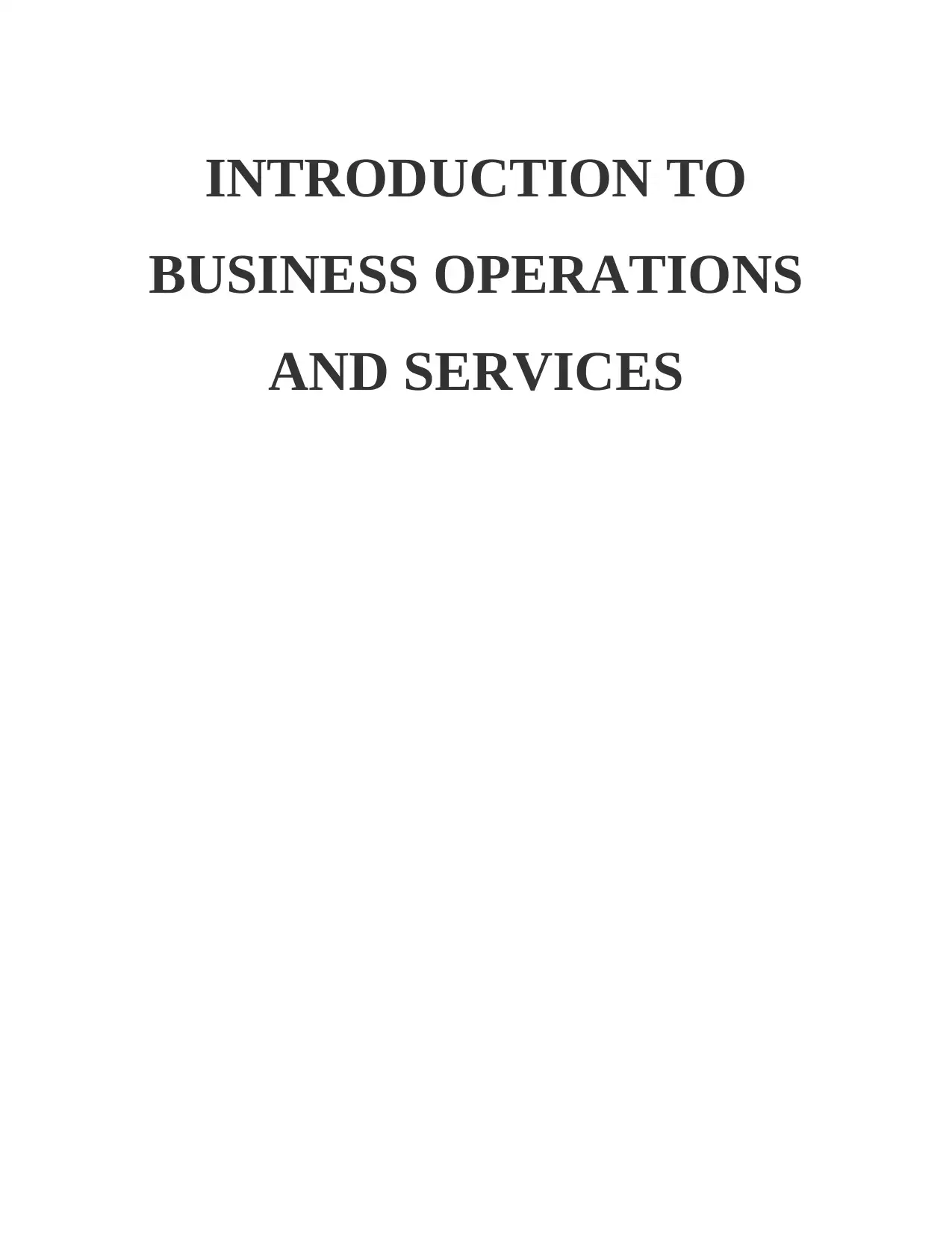
INTRODUCTION TO
BUSINESS OPERATIONS
AND SERVICES
BUSINESS OPERATIONS
AND SERVICES
Paraphrase This Document
Need a fresh take? Get an instant paraphrase of this document with our AI Paraphraser
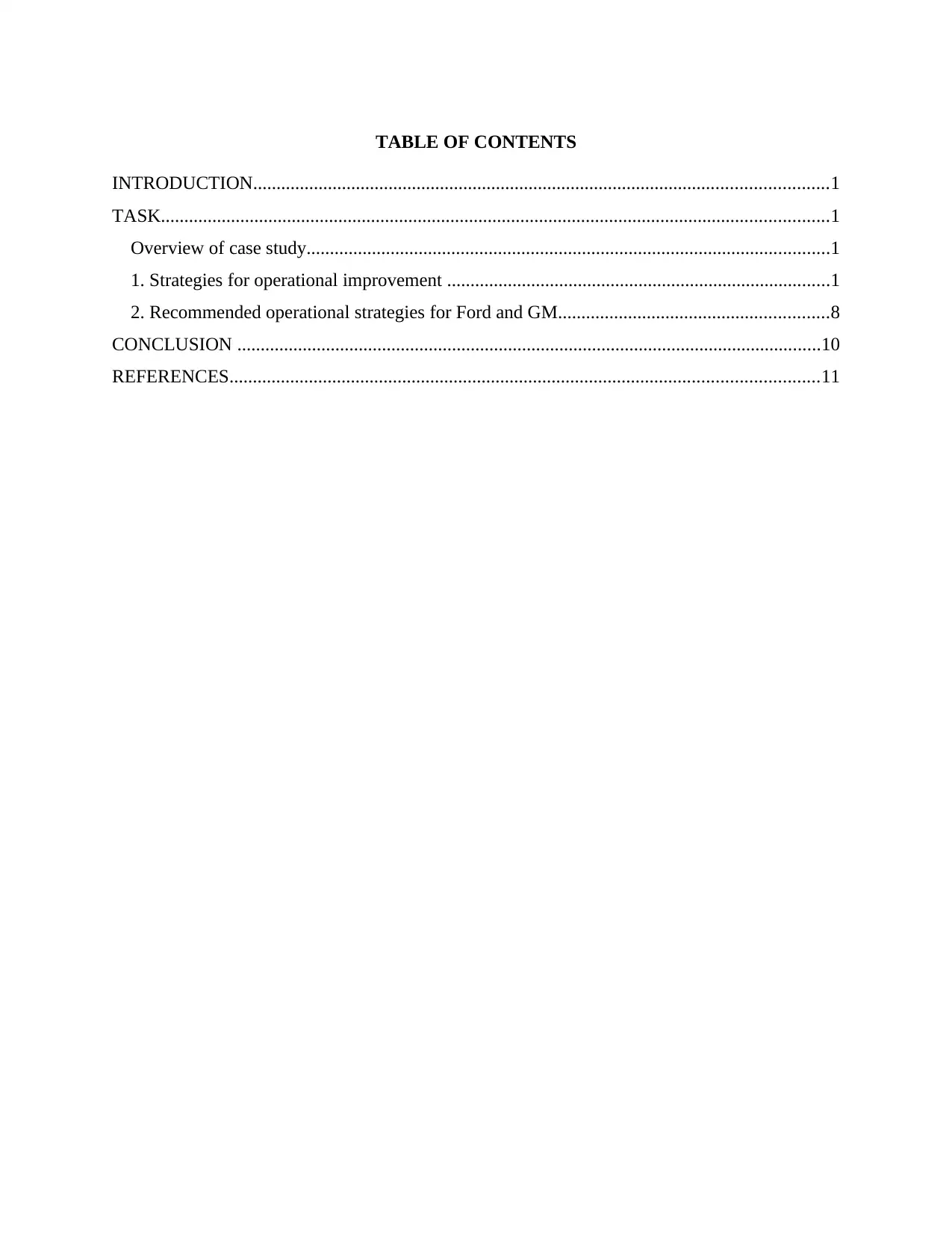
TABLE OF CONTENTS
INTRODUCTION...........................................................................................................................1
TASK...............................................................................................................................................1
Overview of case study................................................................................................................1
1. Strategies for operational improvement ..................................................................................1
2. Recommended operational strategies for Ford and GM..........................................................8
CONCLUSION .............................................................................................................................10
REFERENCES..............................................................................................................................11
INTRODUCTION...........................................................................................................................1
TASK...............................................................................................................................................1
Overview of case study................................................................................................................1
1. Strategies for operational improvement ..................................................................................1
2. Recommended operational strategies for Ford and GM..........................................................8
CONCLUSION .............................................................................................................................10
REFERENCES..............................................................................................................................11
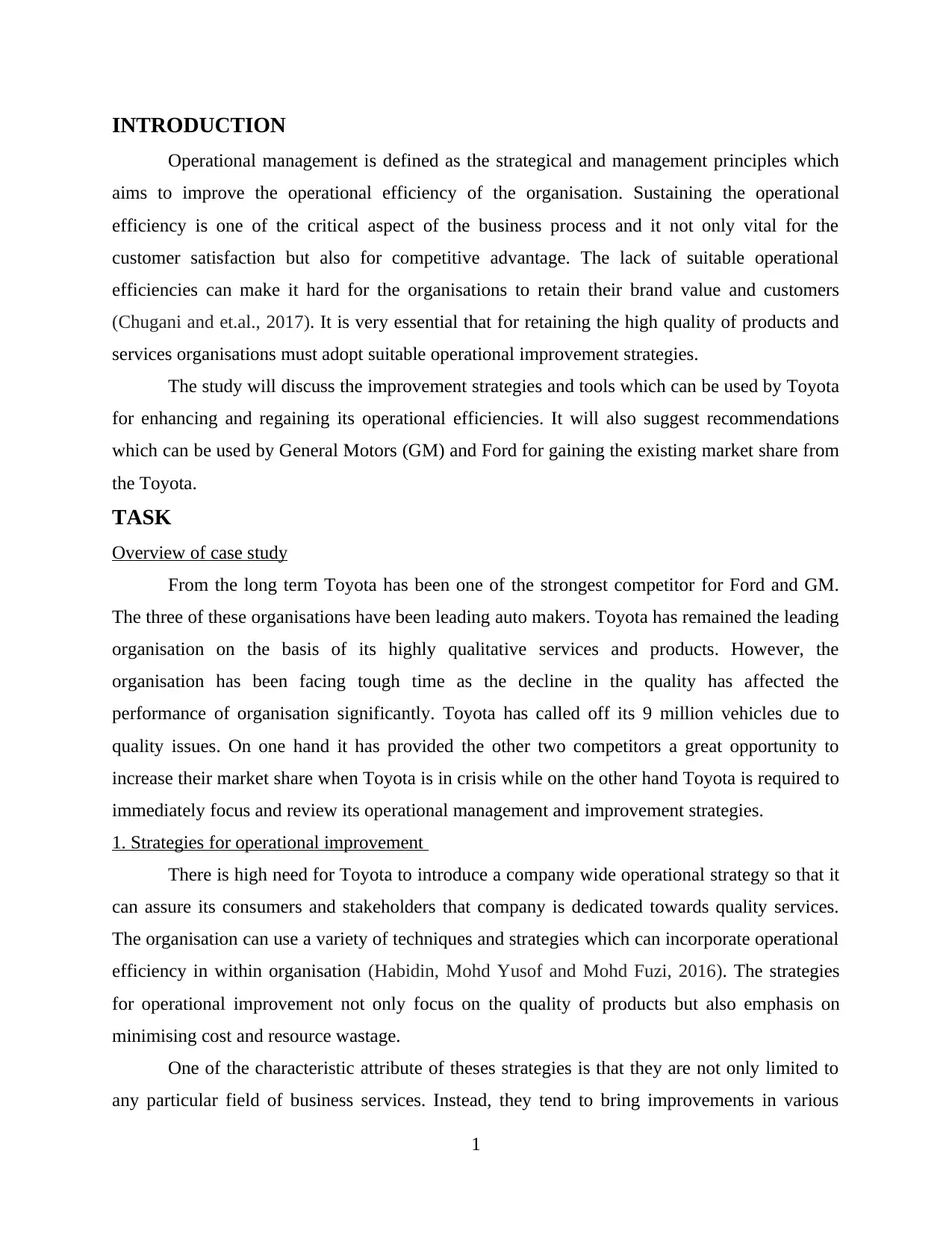
INTRODUCTION
Operational management is defined as the strategical and management principles which
aims to improve the operational efficiency of the organisation. Sustaining the operational
efficiency is one of the critical aspect of the business process and it not only vital for the
customer satisfaction but also for competitive advantage. The lack of suitable operational
efficiencies can make it hard for the organisations to retain their brand value and customers
(Chugani and et.al., 2017). It is very essential that for retaining the high quality of products and
services organisations must adopt suitable operational improvement strategies.
The study will discuss the improvement strategies and tools which can be used by Toyota
for enhancing and regaining its operational efficiencies. It will also suggest recommendations
which can be used by General Motors (GM) and Ford for gaining the existing market share from
the Toyota.
TASK
Overview of case study
From the long term Toyota has been one of the strongest competitor for Ford and GM.
The three of these organisations have been leading auto makers. Toyota has remained the leading
organisation on the basis of its highly qualitative services and products. However, the
organisation has been facing tough time as the decline in the quality has affected the
performance of organisation significantly. Toyota has called off its 9 million vehicles due to
quality issues. On one hand it has provided the other two competitors a great opportunity to
increase their market share when Toyota is in crisis while on the other hand Toyota is required to
immediately focus and review its operational management and improvement strategies.
1. Strategies for operational improvement
There is high need for Toyota to introduce a company wide operational strategy so that it
can assure its consumers and stakeholders that company is dedicated towards quality services.
The organisation can use a variety of techniques and strategies which can incorporate operational
efficiency in within organisation (Habidin, Mohd Yusof and Mohd Fuzi, 2016). The strategies
for operational improvement not only focus on the quality of products but also emphasis on
minimising cost and resource wastage.
One of the characteristic attribute of theses strategies is that they are not only limited to
any particular field of business services. Instead, they tend to bring improvements in various
1
Operational management is defined as the strategical and management principles which
aims to improve the operational efficiency of the organisation. Sustaining the operational
efficiency is one of the critical aspect of the business process and it not only vital for the
customer satisfaction but also for competitive advantage. The lack of suitable operational
efficiencies can make it hard for the organisations to retain their brand value and customers
(Chugani and et.al., 2017). It is very essential that for retaining the high quality of products and
services organisations must adopt suitable operational improvement strategies.
The study will discuss the improvement strategies and tools which can be used by Toyota
for enhancing and regaining its operational efficiencies. It will also suggest recommendations
which can be used by General Motors (GM) and Ford for gaining the existing market share from
the Toyota.
TASK
Overview of case study
From the long term Toyota has been one of the strongest competitor for Ford and GM.
The three of these organisations have been leading auto makers. Toyota has remained the leading
organisation on the basis of its highly qualitative services and products. However, the
organisation has been facing tough time as the decline in the quality has affected the
performance of organisation significantly. Toyota has called off its 9 million vehicles due to
quality issues. On one hand it has provided the other two competitors a great opportunity to
increase their market share when Toyota is in crisis while on the other hand Toyota is required to
immediately focus and review its operational management and improvement strategies.
1. Strategies for operational improvement
There is high need for Toyota to introduce a company wide operational strategy so that it
can assure its consumers and stakeholders that company is dedicated towards quality services.
The organisation can use a variety of techniques and strategies which can incorporate operational
efficiency in within organisation (Habidin, Mohd Yusof and Mohd Fuzi, 2016). The strategies
for operational improvement not only focus on the quality of products but also emphasis on
minimising cost and resource wastage.
One of the characteristic attribute of theses strategies is that they are not only limited to
any particular field of business services. Instead, they tend to bring improvements in various
1
⊘ This is a preview!⊘
Do you want full access?
Subscribe today to unlock all pages.

Trusted by 1+ million students worldwide
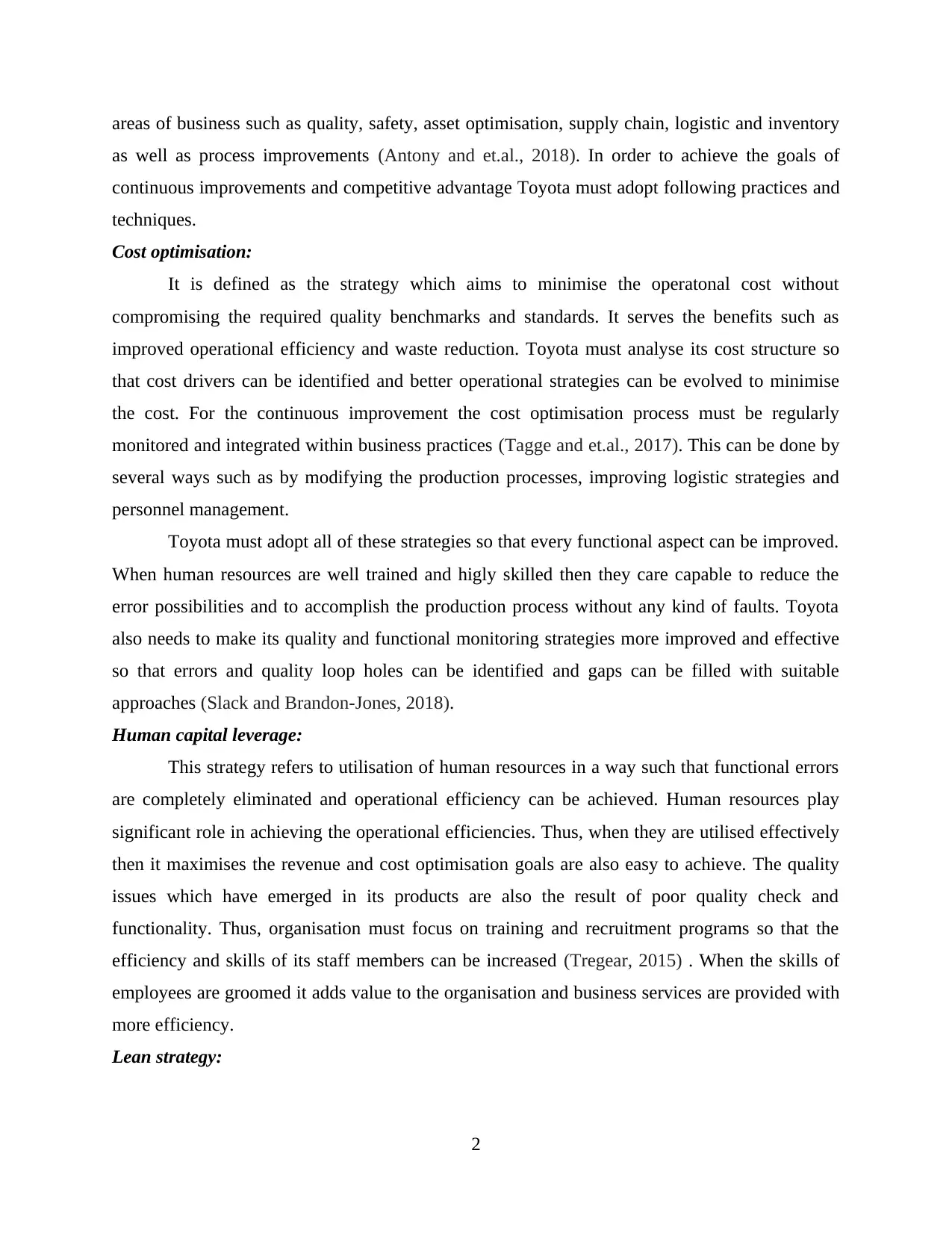
areas of business such as quality, safety, asset optimisation, supply chain, logistic and inventory
as well as process improvements (Antony and et.al., 2018). In order to achieve the goals of
continuous improvements and competitive advantage Toyota must adopt following practices and
techniques.
Cost optimisation:
It is defined as the strategy which aims to minimise the operatonal cost without
compromising the required quality benchmarks and standards. It serves the benefits such as
improved operational efficiency and waste reduction. Toyota must analyse its cost structure so
that cost drivers can be identified and better operational strategies can be evolved to minimise
the cost. For the continuous improvement the cost optimisation process must be regularly
monitored and integrated within business practices (Tagge and et.al., 2017). This can be done by
several ways such as by modifying the production processes, improving logistic strategies and
personnel management.
Toyota must adopt all of these strategies so that every functional aspect can be improved.
When human resources are well trained and higly skilled then they care capable to reduce the
error possibilities and to accomplish the production process without any kind of faults. Toyota
also needs to make its quality and functional monitoring strategies more improved and effective
so that errors and quality loop holes can be identified and gaps can be filled with suitable
approaches (Slack and Brandon-Jones, 2018).
Human capital leverage:
This strategy refers to utilisation of human resources in a way such that functional errors
are completely eliminated and operational efficiency can be achieved. Human resources play
significant role in achieving the operational efficiencies. Thus, when they are utilised effectively
then it maximises the revenue and cost optimisation goals are also easy to achieve. The quality
issues which have emerged in its products are also the result of poor quality check and
functionality. Thus, organisation must focus on training and recruitment programs so that the
efficiency and skills of its staff members can be increased (Tregear, 2015) . When the skills of
employees are groomed it adds value to the organisation and business services are provided with
more efficiency.
Lean strategy:
2
as well as process improvements (Antony and et.al., 2018). In order to achieve the goals of
continuous improvements and competitive advantage Toyota must adopt following practices and
techniques.
Cost optimisation:
It is defined as the strategy which aims to minimise the operatonal cost without
compromising the required quality benchmarks and standards. It serves the benefits such as
improved operational efficiency and waste reduction. Toyota must analyse its cost structure so
that cost drivers can be identified and better operational strategies can be evolved to minimise
the cost. For the continuous improvement the cost optimisation process must be regularly
monitored and integrated within business practices (Tagge and et.al., 2017). This can be done by
several ways such as by modifying the production processes, improving logistic strategies and
personnel management.
Toyota must adopt all of these strategies so that every functional aspect can be improved.
When human resources are well trained and higly skilled then they care capable to reduce the
error possibilities and to accomplish the production process without any kind of faults. Toyota
also needs to make its quality and functional monitoring strategies more improved and effective
so that errors and quality loop holes can be identified and gaps can be filled with suitable
approaches (Slack and Brandon-Jones, 2018).
Human capital leverage:
This strategy refers to utilisation of human resources in a way such that functional errors
are completely eliminated and operational efficiency can be achieved. Human resources play
significant role in achieving the operational efficiencies. Thus, when they are utilised effectively
then it maximises the revenue and cost optimisation goals are also easy to achieve. The quality
issues which have emerged in its products are also the result of poor quality check and
functionality. Thus, organisation must focus on training and recruitment programs so that the
efficiency and skills of its staff members can be increased (Tregear, 2015) . When the skills of
employees are groomed it adds value to the organisation and business services are provided with
more efficiency.
Lean strategy:
2
Paraphrase This Document
Need a fresh take? Get an instant paraphrase of this document with our AI Paraphraser
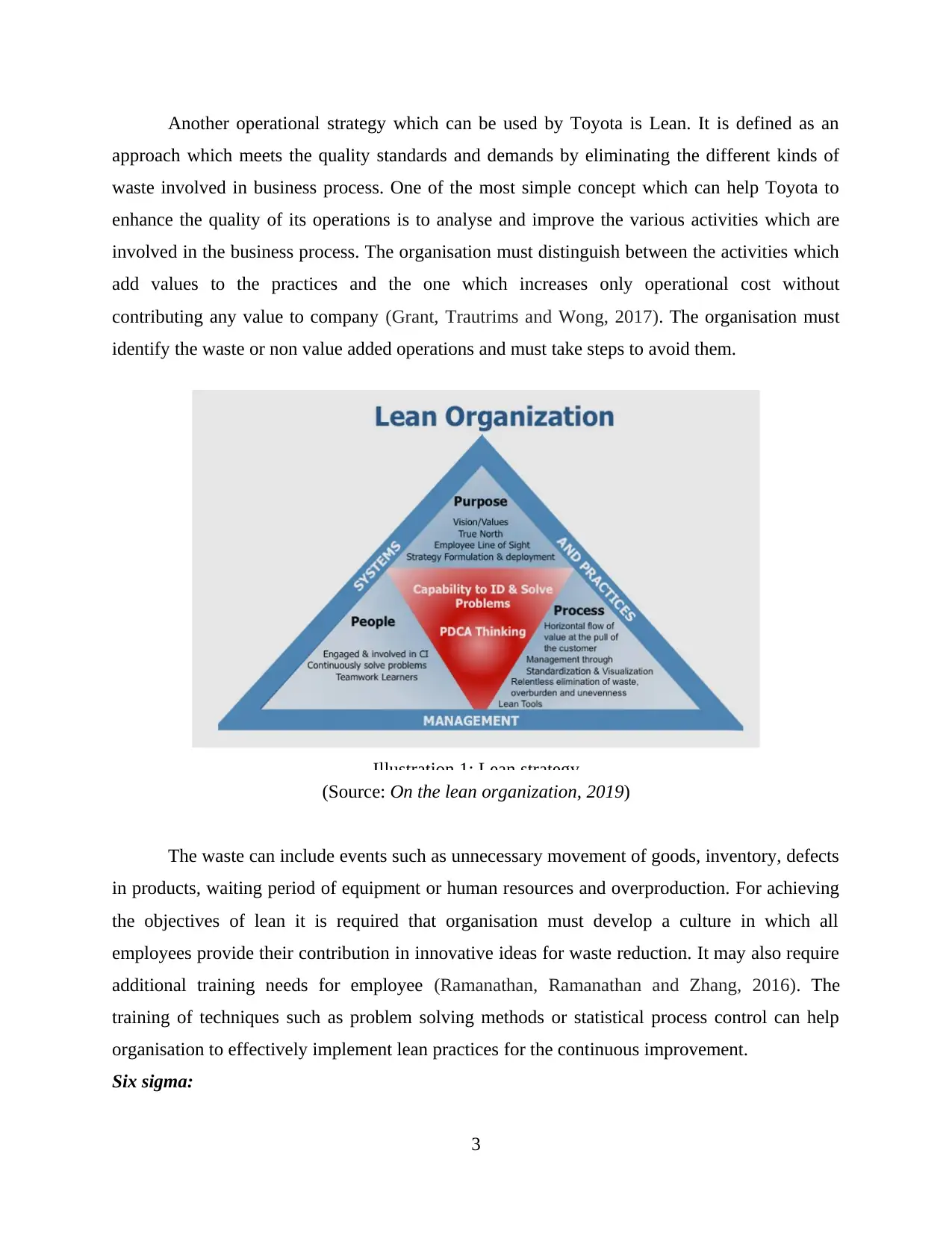
Another operational strategy which can be used by Toyota is Lean. It is defined as an
approach which meets the quality standards and demands by eliminating the different kinds of
waste involved in business process. One of the most simple concept which can help Toyota to
enhance the quality of its operations is to analyse and improve the various activities which are
involved in the business process. The organisation must distinguish between the activities which
add values to the practices and the one which increases only operational cost without
contributing any value to company (Grant, Trautrims and Wong, 2017). The organisation must
identify the waste or non value added operations and must take steps to avoid them.
(Source: On the lean organization, 2019)
The waste can include events such as unnecessary movement of goods, inventory, defects
in products, waiting period of equipment or human resources and overproduction. For achieving
the objectives of lean it is required that organisation must develop a culture in which all
employees provide their contribution in innovative ideas for waste reduction. It may also require
additional training needs for employee (Ramanathan, Ramanathan and Zhang, 2016). The
training of techniques such as problem solving methods or statistical process control can help
organisation to effectively implement lean practices for the continuous improvement.
Six sigma:
3
Illustration 1: Lean strategy
approach which meets the quality standards and demands by eliminating the different kinds of
waste involved in business process. One of the most simple concept which can help Toyota to
enhance the quality of its operations is to analyse and improve the various activities which are
involved in the business process. The organisation must distinguish between the activities which
add values to the practices and the one which increases only operational cost without
contributing any value to company (Grant, Trautrims and Wong, 2017). The organisation must
identify the waste or non value added operations and must take steps to avoid them.
(Source: On the lean organization, 2019)
The waste can include events such as unnecessary movement of goods, inventory, defects
in products, waiting period of equipment or human resources and overproduction. For achieving
the objectives of lean it is required that organisation must develop a culture in which all
employees provide their contribution in innovative ideas for waste reduction. It may also require
additional training needs for employee (Ramanathan, Ramanathan and Zhang, 2016). The
training of techniques such as problem solving methods or statistical process control can help
organisation to effectively implement lean practices for the continuous improvement.
Six sigma:
3
Illustration 1: Lean strategy
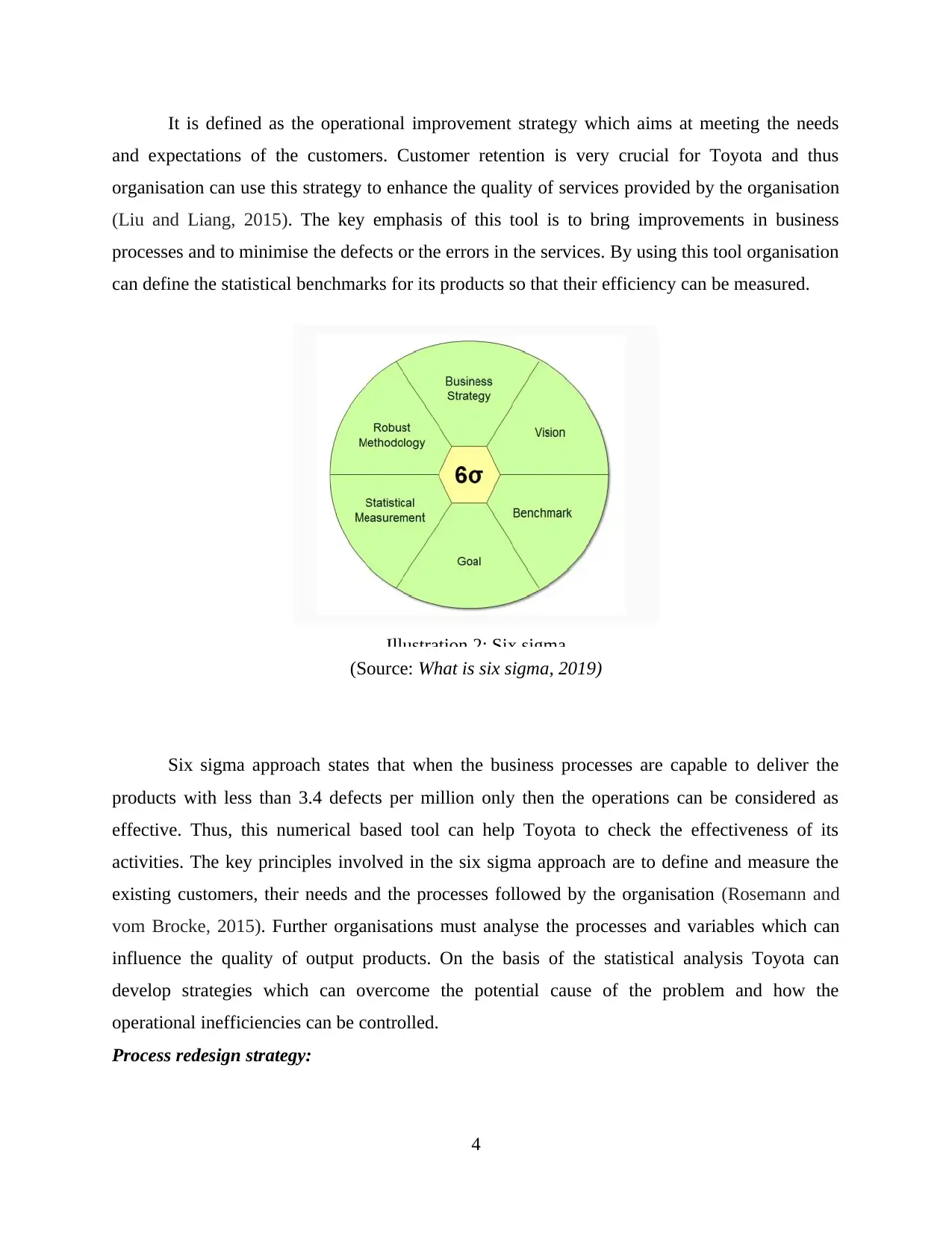
It is defined as the operational improvement strategy which aims at meeting the needs
and expectations of the customers. Customer retention is very crucial for Toyota and thus
organisation can use this strategy to enhance the quality of services provided by the organisation
(Liu and Liang, 2015). The key emphasis of this tool is to bring improvements in business
processes and to minimise the defects or the errors in the services. By using this tool organisation
can define the statistical benchmarks for its products so that their efficiency can be measured.
(Source: What is six sigma, 2019)
Six sigma approach states that when the business processes are capable to deliver the
products with less than 3.4 defects per million only then the operations can be considered as
effective. Thus, this numerical based tool can help Toyota to check the effectiveness of its
activities. The key principles involved in the six sigma approach are to define and measure the
existing customers, their needs and the processes followed by the organisation (Rosemann and
vom Brocke, 2015). Further organisations must analyse the processes and variables which can
influence the quality of output products. On the basis of the statistical analysis Toyota can
develop strategies which can overcome the potential cause of the problem and how the
operational inefficiencies can be controlled.
Process redesign strategy:
4
Illustration 2: Six sigma
and expectations of the customers. Customer retention is very crucial for Toyota and thus
organisation can use this strategy to enhance the quality of services provided by the organisation
(Liu and Liang, 2015). The key emphasis of this tool is to bring improvements in business
processes and to minimise the defects or the errors in the services. By using this tool organisation
can define the statistical benchmarks for its products so that their efficiency can be measured.
(Source: What is six sigma, 2019)
Six sigma approach states that when the business processes are capable to deliver the
products with less than 3.4 defects per million only then the operations can be considered as
effective. Thus, this numerical based tool can help Toyota to check the effectiveness of its
activities. The key principles involved in the six sigma approach are to define and measure the
existing customers, their needs and the processes followed by the organisation (Rosemann and
vom Brocke, 2015). Further organisations must analyse the processes and variables which can
influence the quality of output products. On the basis of the statistical analysis Toyota can
develop strategies which can overcome the potential cause of the problem and how the
operational inefficiencies can be controlled.
Process redesign strategy:
4
Illustration 2: Six sigma
⊘ This is a preview!⊘
Do you want full access?
Subscribe today to unlock all pages.

Trusted by 1+ million students worldwide
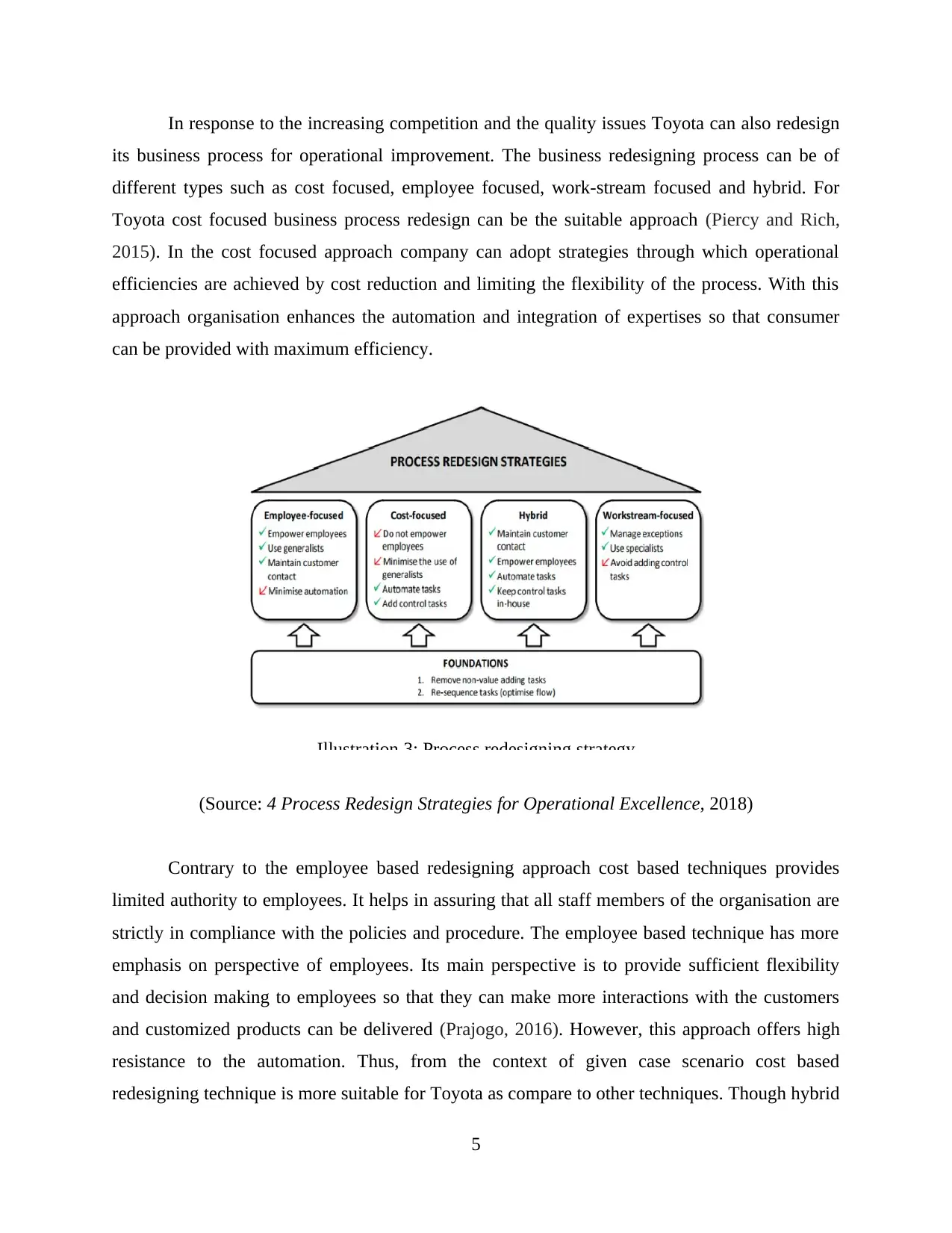
In response to the increasing competition and the quality issues Toyota can also redesign
its business process for operational improvement. The business redesigning process can be of
different types such as cost focused, employee focused, work-stream focused and hybrid. For
Toyota cost focused business process redesign can be the suitable approach (Piercy and Rich,
2015). In the cost focused approach company can adopt strategies through which operational
efficiencies are achieved by cost reduction and limiting the flexibility of the process. With this
approach organisation enhances the automation and integration of expertises so that consumer
can be provided with maximum efficiency.
(Source: 4 Process Redesign Strategies for Operational Excellence, 2018)
Contrary to the employee based redesigning approach cost based techniques provides
limited authority to employees. It helps in assuring that all staff members of the organisation are
strictly in compliance with the policies and procedure. The employee based technique has more
emphasis on perspective of employees. Its main perspective is to provide sufficient flexibility
and decision making to employees so that they can make more interactions with the customers
and customized products can be delivered (Prajogo, 2016). However, this approach offers high
resistance to the automation. Thus, from the context of given case scenario cost based
redesigning technique is more suitable for Toyota as compare to other techniques. Though hybrid
5
Illustration 3: Process redesigning strategy
its business process for operational improvement. The business redesigning process can be of
different types such as cost focused, employee focused, work-stream focused and hybrid. For
Toyota cost focused business process redesign can be the suitable approach (Piercy and Rich,
2015). In the cost focused approach company can adopt strategies through which operational
efficiencies are achieved by cost reduction and limiting the flexibility of the process. With this
approach organisation enhances the automation and integration of expertises so that consumer
can be provided with maximum efficiency.
(Source: 4 Process Redesign Strategies for Operational Excellence, 2018)
Contrary to the employee based redesigning approach cost based techniques provides
limited authority to employees. It helps in assuring that all staff members of the organisation are
strictly in compliance with the policies and procedure. The employee based technique has more
emphasis on perspective of employees. Its main perspective is to provide sufficient flexibility
and decision making to employees so that they can make more interactions with the customers
and customized products can be delivered (Prajogo, 2016). However, this approach offers high
resistance to the automation. Thus, from the context of given case scenario cost based
redesigning technique is more suitable for Toyota as compare to other techniques. Though hybrid
5
Illustration 3: Process redesigning strategy
Paraphrase This Document
Need a fresh take? Get an instant paraphrase of this document with our AI Paraphraser
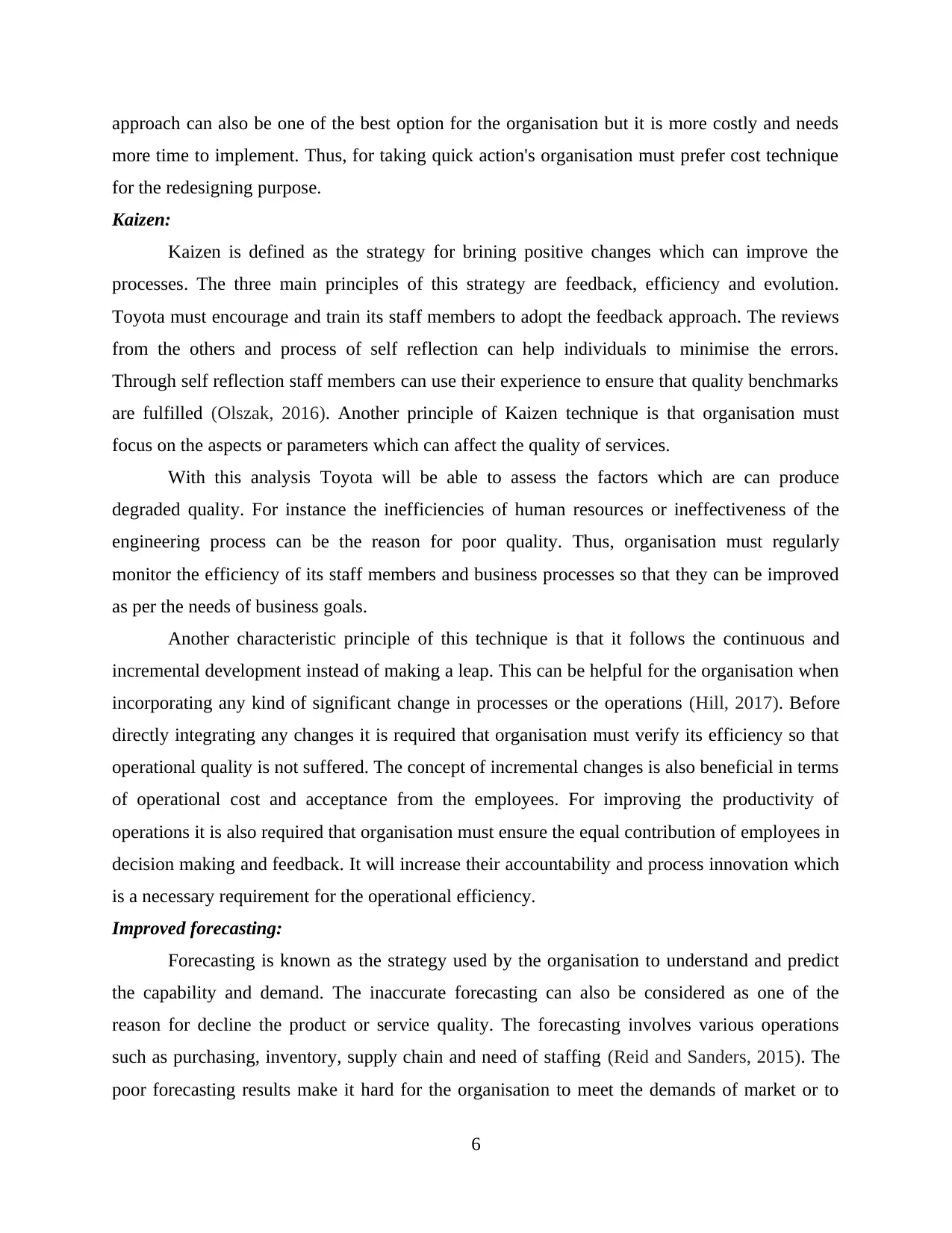
approach can also be one of the best option for the organisation but it is more costly and needs
more time to implement. Thus, for taking quick action's organisation must prefer cost technique
for the redesigning purpose.
Kaizen:
Kaizen is defined as the strategy for brining positive changes which can improve the
processes. The three main principles of this strategy are feedback, efficiency and evolution.
Toyota must encourage and train its staff members to adopt the feedback approach. The reviews
from the others and process of self reflection can help individuals to minimise the errors.
Through self reflection staff members can use their experience to ensure that quality benchmarks
are fulfilled (Olszak, 2016). Another principle of Kaizen technique is that organisation must
focus on the aspects or parameters which can affect the quality of services.
With this analysis Toyota will be able to assess the factors which are can produce
degraded quality. For instance the inefficiencies of human resources or ineffectiveness of the
engineering process can be the reason for poor quality. Thus, organisation must regularly
monitor the efficiency of its staff members and business processes so that they can be improved
as per the needs of business goals.
Another characteristic principle of this technique is that it follows the continuous and
incremental development instead of making a leap. This can be helpful for the organisation when
incorporating any kind of significant change in processes or the operations (Hill, 2017). Before
directly integrating any changes it is required that organisation must verify its efficiency so that
operational quality is not suffered. The concept of incremental changes is also beneficial in terms
of operational cost and acceptance from the employees. For improving the productivity of
operations it is also required that organisation must ensure the equal contribution of employees in
decision making and feedback. It will increase their accountability and process innovation which
is a necessary requirement for the operational efficiency.
Improved forecasting:
Forecasting is known as the strategy used by the organisation to understand and predict
the capability and demand. The inaccurate forecasting can also be considered as one of the
reason for decline the product or service quality. The forecasting involves various operations
such as purchasing, inventory, supply chain and need of staffing (Reid and Sanders, 2015). The
poor forecasting results make it hard for the organisation to meet the demands of market or to
6
more time to implement. Thus, for taking quick action's organisation must prefer cost technique
for the redesigning purpose.
Kaizen:
Kaizen is defined as the strategy for brining positive changes which can improve the
processes. The three main principles of this strategy are feedback, efficiency and evolution.
Toyota must encourage and train its staff members to adopt the feedback approach. The reviews
from the others and process of self reflection can help individuals to minimise the errors.
Through self reflection staff members can use their experience to ensure that quality benchmarks
are fulfilled (Olszak, 2016). Another principle of Kaizen technique is that organisation must
focus on the aspects or parameters which can affect the quality of services.
With this analysis Toyota will be able to assess the factors which are can produce
degraded quality. For instance the inefficiencies of human resources or ineffectiveness of the
engineering process can be the reason for poor quality. Thus, organisation must regularly
monitor the efficiency of its staff members and business processes so that they can be improved
as per the needs of business goals.
Another characteristic principle of this technique is that it follows the continuous and
incremental development instead of making a leap. This can be helpful for the organisation when
incorporating any kind of significant change in processes or the operations (Hill, 2017). Before
directly integrating any changes it is required that organisation must verify its efficiency so that
operational quality is not suffered. The concept of incremental changes is also beneficial in terms
of operational cost and acceptance from the employees. For improving the productivity of
operations it is also required that organisation must ensure the equal contribution of employees in
decision making and feedback. It will increase their accountability and process innovation which
is a necessary requirement for the operational efficiency.
Improved forecasting:
Forecasting is known as the strategy used by the organisation to understand and predict
the capability and demand. The inaccurate forecasting can also be considered as one of the
reason for decline the product or service quality. The forecasting involves various operations
such as purchasing, inventory, supply chain and need of staffing (Reid and Sanders, 2015). The
poor forecasting results make it hard for the organisation to meet the demands of market or to
6
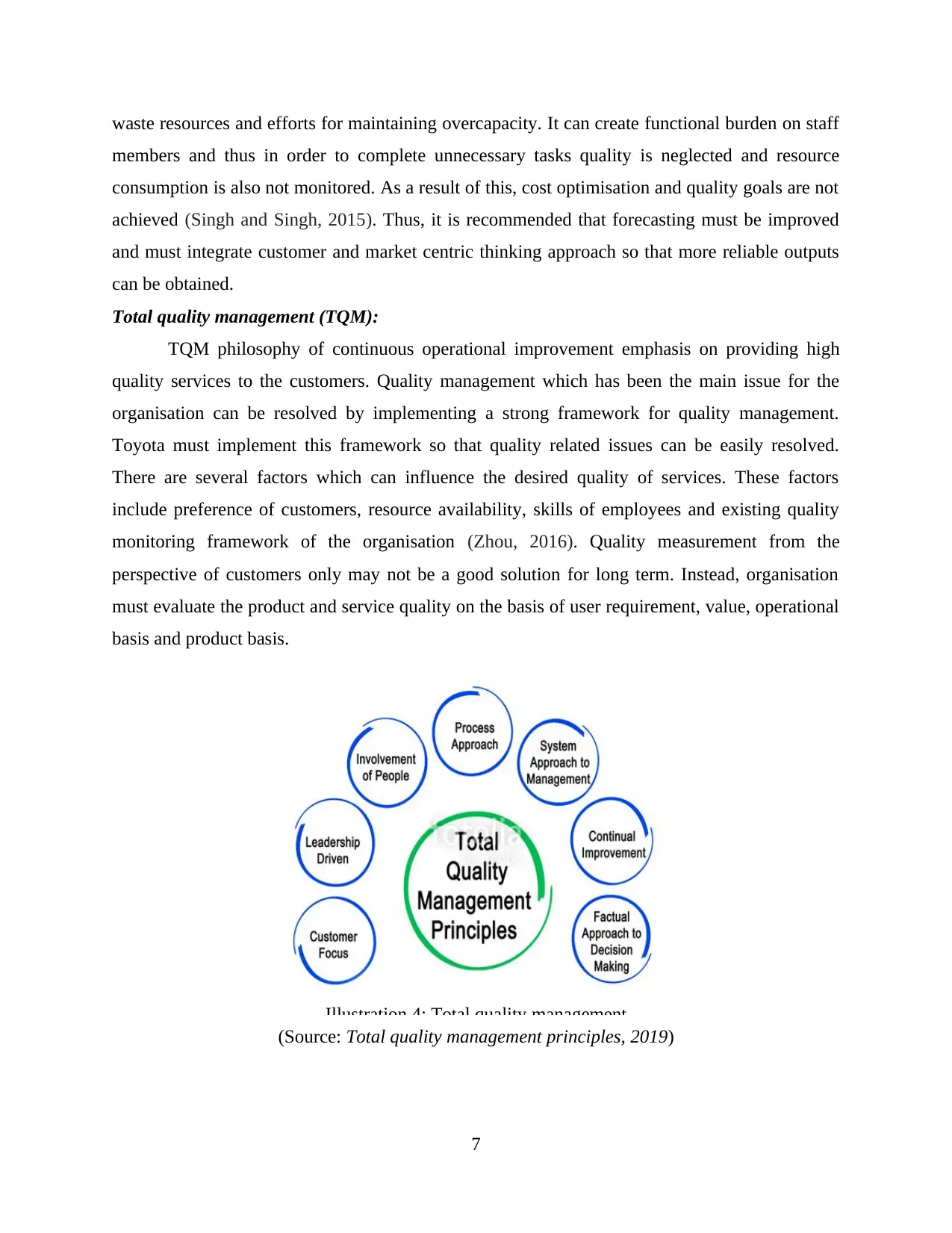
waste resources and efforts for maintaining overcapacity. It can create functional burden on staff
members and thus in order to complete unnecessary tasks quality is neglected and resource
consumption is also not monitored. As a result of this, cost optimisation and quality goals are not
achieved (Singh and Singh, 2015). Thus, it is recommended that forecasting must be improved
and must integrate customer and market centric thinking approach so that more reliable outputs
can be obtained.
Total quality management (TQM):
TQM philosophy of continuous operational improvement emphasis on providing high
quality services to the customers. Quality management which has been the main issue for the
organisation can be resolved by implementing a strong framework for quality management.
Toyota must implement this framework so that quality related issues can be easily resolved.
There are several factors which can influence the desired quality of services. These factors
include preference of customers, resource availability, skills of employees and existing quality
monitoring framework of the organisation (Zhou, 2016). Quality measurement from the
perspective of customers only may not be a good solution for long term. Instead, organisation
must evaluate the product and service quality on the basis of user requirement, value, operational
basis and product basis.
(Source: Total quality management principles, 2019)
7
Illustration 4: Total quality management
members and thus in order to complete unnecessary tasks quality is neglected and resource
consumption is also not monitored. As a result of this, cost optimisation and quality goals are not
achieved (Singh and Singh, 2015). Thus, it is recommended that forecasting must be improved
and must integrate customer and market centric thinking approach so that more reliable outputs
can be obtained.
Total quality management (TQM):
TQM philosophy of continuous operational improvement emphasis on providing high
quality services to the customers. Quality management which has been the main issue for the
organisation can be resolved by implementing a strong framework for quality management.
Toyota must implement this framework so that quality related issues can be easily resolved.
There are several factors which can influence the desired quality of services. These factors
include preference of customers, resource availability, skills of employees and existing quality
monitoring framework of the organisation (Zhou, 2016). Quality measurement from the
perspective of customers only may not be a good solution for long term. Instead, organisation
must evaluate the product and service quality on the basis of user requirement, value, operational
basis and product basis.
(Source: Total quality management principles, 2019)
7
Illustration 4: Total quality management
⊘ This is a preview!⊘
Do you want full access?
Subscribe today to unlock all pages.

Trusted by 1+ million students worldwide
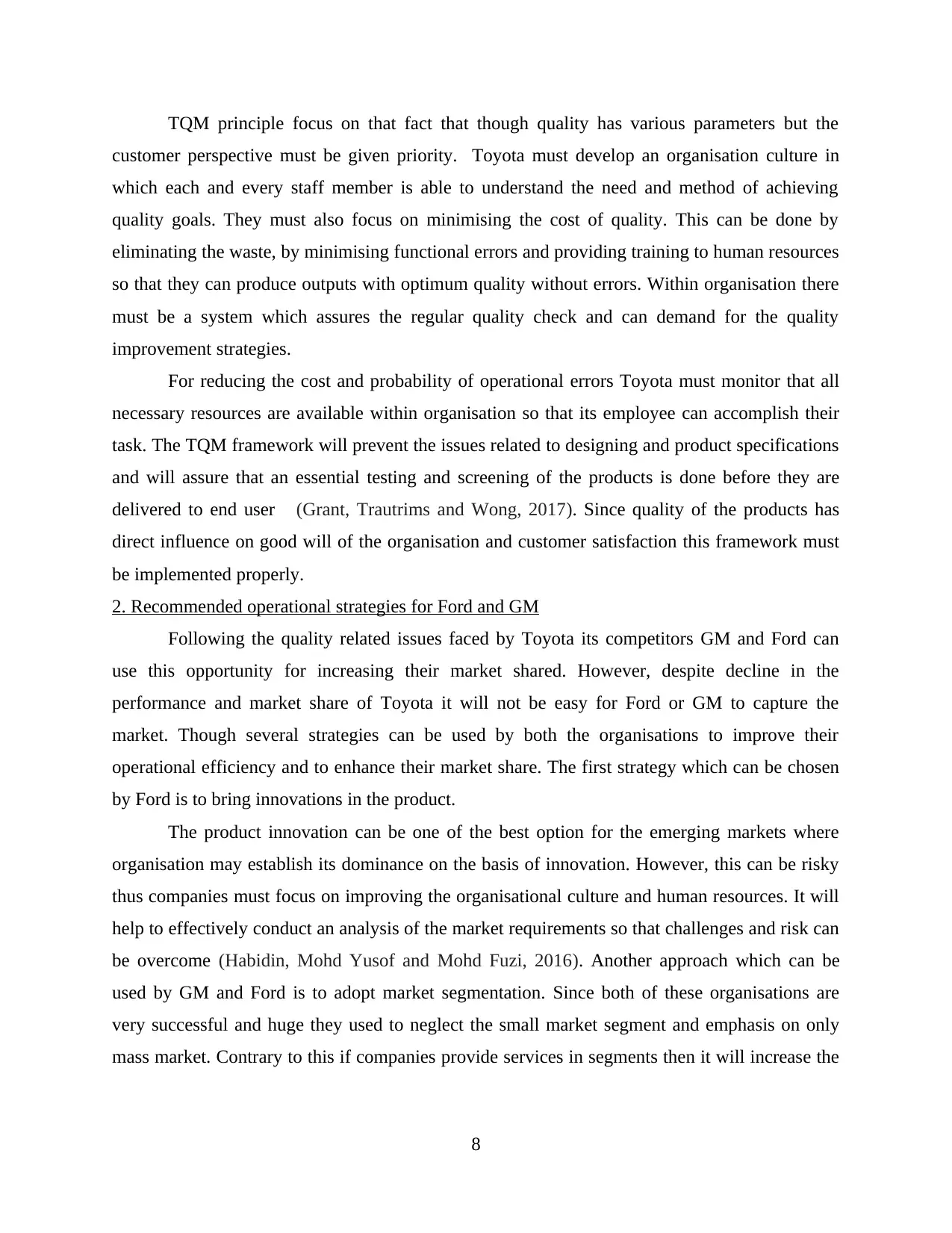
TQM principle focus on that fact that though quality has various parameters but the
customer perspective must be given priority. Toyota must develop an organisation culture in
which each and every staff member is able to understand the need and method of achieving
quality goals. They must also focus on minimising the cost of quality. This can be done by
eliminating the waste, by minimising functional errors and providing training to human resources
so that they can produce outputs with optimum quality without errors. Within organisation there
must be a system which assures the regular quality check and can demand for the quality
improvement strategies.
For reducing the cost and probability of operational errors Toyota must monitor that all
necessary resources are available within organisation so that its employee can accomplish their
task. The TQM framework will prevent the issues related to designing and product specifications
and will assure that an essential testing and screening of the products is done before they are
delivered to end user (Grant, Trautrims and Wong, 2017). Since quality of the products has
direct influence on good will of the organisation and customer satisfaction this framework must
be implemented properly.
2. Recommended operational strategies for Ford and GM
Following the quality related issues faced by Toyota its competitors GM and Ford can
use this opportunity for increasing their market shared. However, despite decline in the
performance and market share of Toyota it will not be easy for Ford or GM to capture the
market. Though several strategies can be used by both the organisations to improve their
operational efficiency and to enhance their market share. The first strategy which can be chosen
by Ford is to bring innovations in the product.
The product innovation can be one of the best option for the emerging markets where
organisation may establish its dominance on the basis of innovation. However, this can be risky
thus companies must focus on improving the organisational culture and human resources. It will
help to effectively conduct an analysis of the market requirements so that challenges and risk can
be overcome (Habidin, Mohd Yusof and Mohd Fuzi, 2016). Another approach which can be
used by GM and Ford is to adopt market segmentation. Since both of these organisations are
very successful and huge they used to neglect the small market segment and emphasis on only
mass market. Contrary to this if companies provide services in segments then it will increase the
8
customer perspective must be given priority. Toyota must develop an organisation culture in
which each and every staff member is able to understand the need and method of achieving
quality goals. They must also focus on minimising the cost of quality. This can be done by
eliminating the waste, by minimising functional errors and providing training to human resources
so that they can produce outputs with optimum quality without errors. Within organisation there
must be a system which assures the regular quality check and can demand for the quality
improvement strategies.
For reducing the cost and probability of operational errors Toyota must monitor that all
necessary resources are available within organisation so that its employee can accomplish their
task. The TQM framework will prevent the issues related to designing and product specifications
and will assure that an essential testing and screening of the products is done before they are
delivered to end user (Grant, Trautrims and Wong, 2017). Since quality of the products has
direct influence on good will of the organisation and customer satisfaction this framework must
be implemented properly.
2. Recommended operational strategies for Ford and GM
Following the quality related issues faced by Toyota its competitors GM and Ford can
use this opportunity for increasing their market shared. However, despite decline in the
performance and market share of Toyota it will not be easy for Ford or GM to capture the
market. Though several strategies can be used by both the organisations to improve their
operational efficiency and to enhance their market share. The first strategy which can be chosen
by Ford is to bring innovations in the product.
The product innovation can be one of the best option for the emerging markets where
organisation may establish its dominance on the basis of innovation. However, this can be risky
thus companies must focus on improving the organisational culture and human resources. It will
help to effectively conduct an analysis of the market requirements so that challenges and risk can
be overcome (Habidin, Mohd Yusof and Mohd Fuzi, 2016). Another approach which can be
used by GM and Ford is to adopt market segmentation. Since both of these organisations are
very successful and huge they used to neglect the small market segment and emphasis on only
mass market. Contrary to this if companies provide services in segments then it will increase the
8
Paraphrase This Document
Need a fresh take? Get an instant paraphrase of this document with our AI Paraphraser
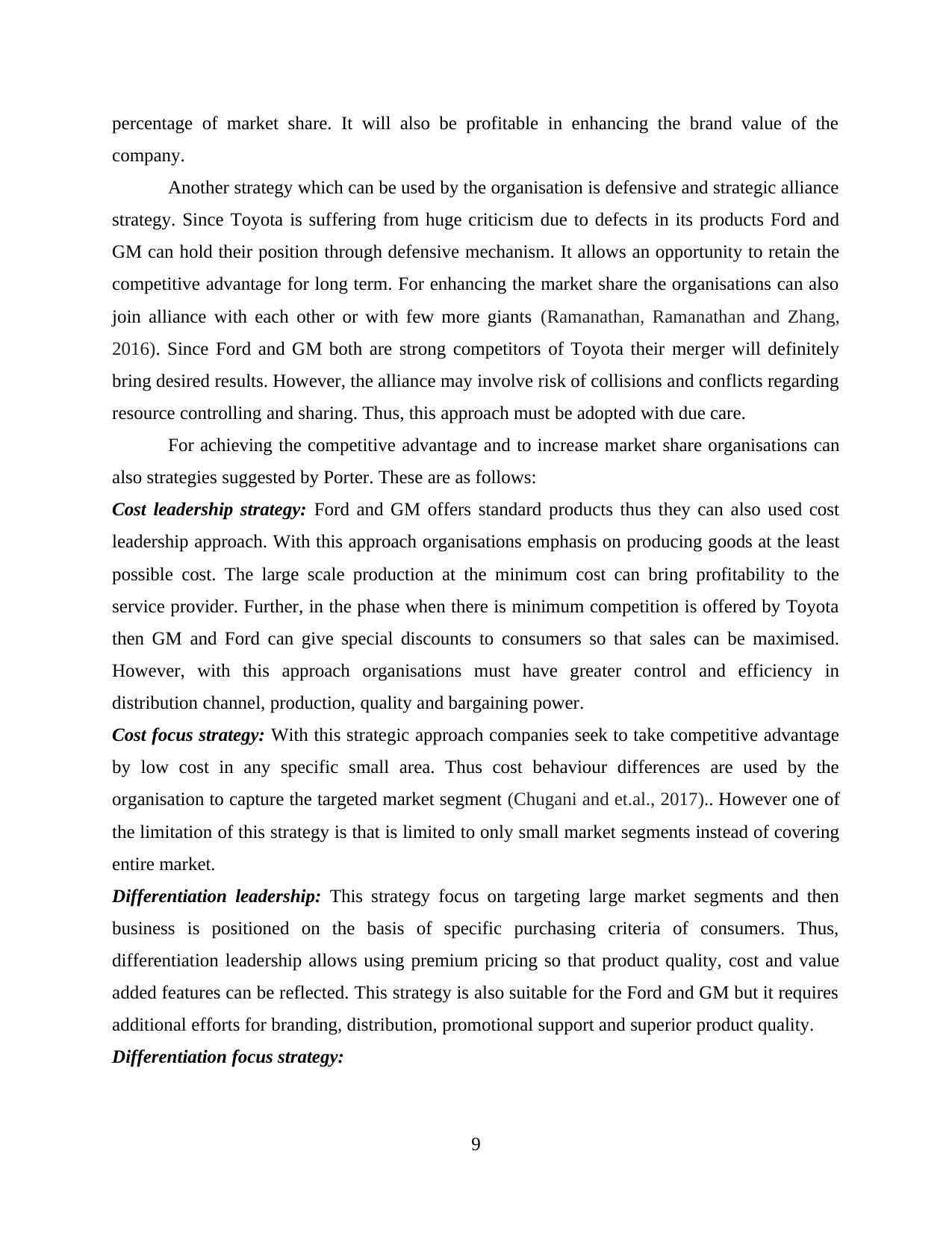
percentage of market share. It will also be profitable in enhancing the brand value of the
company.
Another strategy which can be used by the organisation is defensive and strategic alliance
strategy. Since Toyota is suffering from huge criticism due to defects in its products Ford and
GM can hold their position through defensive mechanism. It allows an opportunity to retain the
competitive advantage for long term. For enhancing the market share the organisations can also
join alliance with each other or with few more giants (Ramanathan, Ramanathan and Zhang,
2016). Since Ford and GM both are strong competitors of Toyota their merger will definitely
bring desired results. However, the alliance may involve risk of collisions and conflicts regarding
resource controlling and sharing. Thus, this approach must be adopted with due care.
For achieving the competitive advantage and to increase market share organisations can
also strategies suggested by Porter. These are as follows:
Cost leadership strategy: Ford and GM offers standard products thus they can also used cost
leadership approach. With this approach organisations emphasis on producing goods at the least
possible cost. The large scale production at the minimum cost can bring profitability to the
service provider. Further, in the phase when there is minimum competition is offered by Toyota
then GM and Ford can give special discounts to consumers so that sales can be maximised.
However, with this approach organisations must have greater control and efficiency in
distribution channel, production, quality and bargaining power.
Cost focus strategy: With this strategic approach companies seek to take competitive advantage
by low cost in any specific small area. Thus cost behaviour differences are used by the
organisation to capture the targeted market segment (Chugani and et.al., 2017).. However one of
the limitation of this strategy is that is limited to only small market segments instead of covering
entire market.
Differentiation leadership: This strategy focus on targeting large market segments and then
business is positioned on the basis of specific purchasing criteria of consumers. Thus,
differentiation leadership allows using premium pricing so that product quality, cost and value
added features can be reflected. This strategy is also suitable for the Ford and GM but it requires
additional efforts for branding, distribution, promotional support and superior product quality.
Differentiation focus strategy:
9
company.
Another strategy which can be used by the organisation is defensive and strategic alliance
strategy. Since Toyota is suffering from huge criticism due to defects in its products Ford and
GM can hold their position through defensive mechanism. It allows an opportunity to retain the
competitive advantage for long term. For enhancing the market share the organisations can also
join alliance with each other or with few more giants (Ramanathan, Ramanathan and Zhang,
2016). Since Ford and GM both are strong competitors of Toyota their merger will definitely
bring desired results. However, the alliance may involve risk of collisions and conflicts regarding
resource controlling and sharing. Thus, this approach must be adopted with due care.
For achieving the competitive advantage and to increase market share organisations can
also strategies suggested by Porter. These are as follows:
Cost leadership strategy: Ford and GM offers standard products thus they can also used cost
leadership approach. With this approach organisations emphasis on producing goods at the least
possible cost. The large scale production at the minimum cost can bring profitability to the
service provider. Further, in the phase when there is minimum competition is offered by Toyota
then GM and Ford can give special discounts to consumers so that sales can be maximised.
However, with this approach organisations must have greater control and efficiency in
distribution channel, production, quality and bargaining power.
Cost focus strategy: With this strategic approach companies seek to take competitive advantage
by low cost in any specific small area. Thus cost behaviour differences are used by the
organisation to capture the targeted market segment (Chugani and et.al., 2017).. However one of
the limitation of this strategy is that is limited to only small market segments instead of covering
entire market.
Differentiation leadership: This strategy focus on targeting large market segments and then
business is positioned on the basis of specific purchasing criteria of consumers. Thus,
differentiation leadership allows using premium pricing so that product quality, cost and value
added features can be reflected. This strategy is also suitable for the Ford and GM but it requires
additional efforts for branding, distribution, promotional support and superior product quality.
Differentiation focus strategy:
9
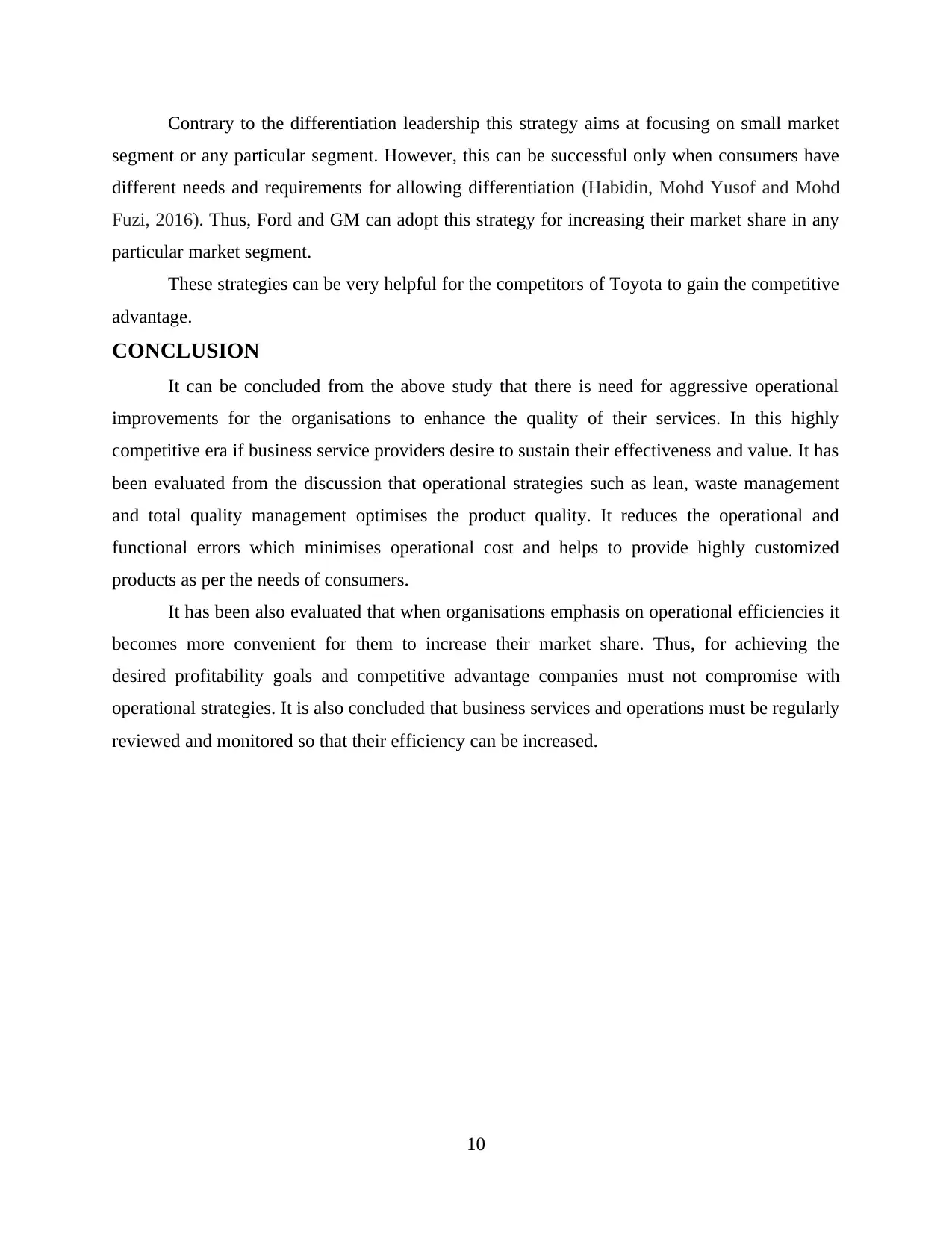
Contrary to the differentiation leadership this strategy aims at focusing on small market
segment or any particular segment. However, this can be successful only when consumers have
different needs and requirements for allowing differentiation (Habidin, Mohd Yusof and Mohd
Fuzi, 2016). Thus, Ford and GM can adopt this strategy for increasing their market share in any
particular market segment.
These strategies can be very helpful for the competitors of Toyota to gain the competitive
advantage.
CONCLUSION
It can be concluded from the above study that there is need for aggressive operational
improvements for the organisations to enhance the quality of their services. In this highly
competitive era if business service providers desire to sustain their effectiveness and value. It has
been evaluated from the discussion that operational strategies such as lean, waste management
and total quality management optimises the product quality. It reduces the operational and
functional errors which minimises operational cost and helps to provide highly customized
products as per the needs of consumers.
It has been also evaluated that when organisations emphasis on operational efficiencies it
becomes more convenient for them to increase their market share. Thus, for achieving the
desired profitability goals and competitive advantage companies must not compromise with
operational strategies. It is also concluded that business services and operations must be regularly
reviewed and monitored so that their efficiency can be increased.
10
segment or any particular segment. However, this can be successful only when consumers have
different needs and requirements for allowing differentiation (Habidin, Mohd Yusof and Mohd
Fuzi, 2016). Thus, Ford and GM can adopt this strategy for increasing their market share in any
particular market segment.
These strategies can be very helpful for the competitors of Toyota to gain the competitive
advantage.
CONCLUSION
It can be concluded from the above study that there is need for aggressive operational
improvements for the organisations to enhance the quality of their services. In this highly
competitive era if business service providers desire to sustain their effectiveness and value. It has
been evaluated from the discussion that operational strategies such as lean, waste management
and total quality management optimises the product quality. It reduces the operational and
functional errors which minimises operational cost and helps to provide highly customized
products as per the needs of consumers.
It has been also evaluated that when organisations emphasis on operational efficiencies it
becomes more convenient for them to increase their market share. Thus, for achieving the
desired profitability goals and competitive advantage companies must not compromise with
operational strategies. It is also concluded that business services and operations must be regularly
reviewed and monitored so that their efficiency can be increased.
10
⊘ This is a preview!⊘
Do you want full access?
Subscribe today to unlock all pages.

Trusted by 1+ million students worldwide
1 out of 19
Related Documents
Your All-in-One AI-Powered Toolkit for Academic Success.
+13062052269
info@desklib.com
Available 24*7 on WhatsApp / Email
![[object Object]](/_next/static/media/star-bottom.7253800d.svg)
Unlock your academic potential
Copyright © 2020–2025 A2Z Services. All Rights Reserved. Developed and managed by ZUCOL.





